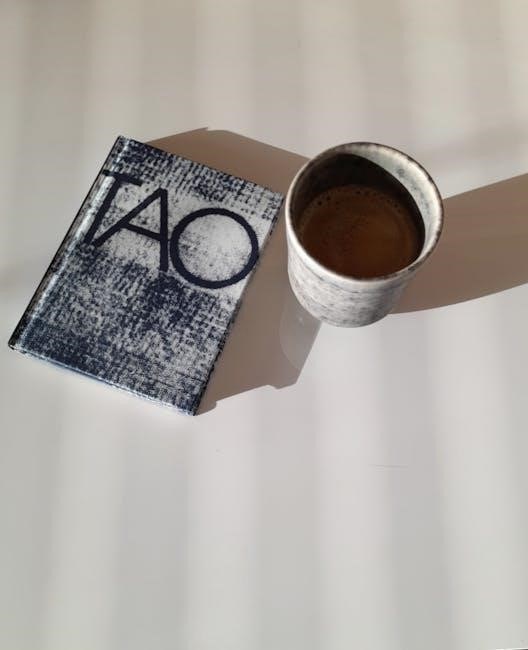The Tao of Jeet Kune Do is a foundational text by Bruce Lee, exploring the philosophy and science behind his martial art. It offers insights into Zen, striking, and footwork, blending practical techniques with mental growth. This iconic book serves as a guide for self-discovery and personal development, emphasizing adaptability and simplicity in combat. Lee’s vision transcends physicality, fostering a holistic understanding of martial arts and life.

Overview of Jeet Kune Do and Its Philosophy
Jeet Kune Do (JKD) is Bruce Lee’s martial philosophy, emphasizing practicality, adaptability, and self-expression. It combines techniques from various martial arts, blending Eastern philosophy with Western efficiency. The term “Tao” reflects the pursuit of balance and harmony, guiding practitioners to embrace simplicity and directness in combat. JKD is not a rigid style but a fluid system, encouraging individuals to adapt and evolve. Its core philosophy revolves around mental clarity, self-discovery, and the unity of mind and body. This approach transcends physical combat, offering a holistic path to personal growth and enlightenment, making it a timeless guide for martial artists and philosophers alike.
Significance of the Term “Tao” in Martial Arts
The term “Tao” in martial arts embodies the principle of harmony and balance, reflecting the natural flow of life. Derived from ancient Chinese philosophy, it symbolizes the path to enlightenment and self-discovery. In Jeet Kune Do, “Tao” represents the unity of opposites, encouraging practitioners to embrace adaptability and fluidity. It transcends physical techniques, emphasizing the cultivation of mental clarity and inner peace. By aligning with the Tao, martial artists achieve a state of effortless action, where movement becomes intuitive and spontaneous. This concept is central to Bruce Lee’s teachings, guiding individuals toward a deeper understanding of themselves and the world around them.
Bruce Lee’s Vision and Contribution to Martial Arts

Bruce Lee revolutionized martial arts by introducing Jeet Kune Do, a philosophy emphasizing practicality, adaptability, and individual expression. His vision transcended traditional styles, advocating for a holistic approach that combined physical techniques with mental and spiritual growth. Lee’s contributions include breaking down cultural barriers and popularizing martial arts globally. Through his teachings, he empowered practitioners to explore their unique potential, fostering a mindset of continuous learning and self-improvement. His legacy endures as a timeless inspiration, influencing not only martial arts but also personal development and modern culture. Lee’s work remains a cornerstone of martial philosophy, guiding seekers toward mastery and self-realization.

Historical Background of Jeet Kune Do
Jeet Kune Do traces its roots to Wing Chun, a 400-year-old martial art, influencing Bruce Lee’s development of JKD as a modern, adaptive combat system.
Origins and Evolution of the Martial Art
Jeet Kune Do’s origins trace back to Wing Chun, a 400-year-old martial art that influenced Bruce Lee’s journey. Lee integrated elements from boxing, fencing, and other styles, evolving JKD into a dynamic, adaptive system. Rooted in Eastern philosophy, JKD emphasizes fluidity and practicality, moving beyond rigid forms. Its development reflects Lee’s belief in constant growth and self-discovery, blending physical techniques with mental and philosophical insights. This evolution transformed JKD into a holistic martial art, focusing on efficiency and simplicity. The art continues to inspire practitioners worldwide, embodying Lee’s vision of freedom and individual expression in combat and life.
Influence of Wing Chun and Other Martial Arts Styles
Wing Chun, a 400-year-old martial art, heavily influenced Bruce Lee’s development of Jeet Kune Do. Its emphasis on efficiency, directness, and simplicity formed the foundation of JKD. Lee also incorporated elements from boxing, fencing, and Filipino martial arts, blending techniques to create a practical and adaptive system. The integration of these styles reflected Lee’s belief in freedom from rigid forms, allowing practitioners to express their individuality. Wing Chun’s core principles, such as centerline theory and economy of motion, remain central to JKD, while other influences expanded its versatility. This fusion of traditions and innovations gave rise to a holistic martial art that prioritizes understanding and self-expression over dogmatic styles.
Bruce Lee’s Journey and Development of JKD
Bruce Lee’s journey in martial arts began with Wing Chun, which he studied under Grandmaster Yip Man. His exploration of various martial arts styles, including boxing and fencing, led him to develop Jeet Kune Do. Lee’s philosophy emphasized practicality and adaptability, rejecting rigid forms for a more fluid approach. His extensive reading and research, spanning thousands of books, influenced his holistic understanding of combat and self-discovery. Lee’s personal evolution from a traditional martial artist to a visionary philosopher laid the groundwork for JKD, a system that combines physical techniques with mental and spiritual growth. His journey reflects a lifelong pursuit of mastery and self-expression.

Core Principles of Jeet Kune Do
Jeet Kune Do emphasizes efficiency, simplicity, and adaptability, focusing on direct and effective techniques. It integrates physical movement with mental discipline, fostering a harmonious mind-body connection.
Adaptability and Practicality in Combat
Adaptability is central to Jeet Kune Do, allowing practitioners to fluidly adjust techniques to suit real-time situations. This approach rejects rigid forms, favoring practical and effective responses. Emphasizing efficiency, JKD encourages the use of minimal effort for maximum impact, ensuring versatility across diverse combat scenarios. The philosophy stresses understanding over memorization, enabling seamless transitions between striking, grappling, and defensive strategies. By focusing on what works best in the moment, JKD practitioners cultivate a dynamic, situation-aware mindset, making it highly effective in modern self-defense applications. This practicality ensures JKD remains relevant and adaptable to contemporary martial arts needs.
Importance of Mental and Philosophical Development
Mental and philosophical growth are cornerstone principles in Jeet Kune Do, emphasizing harmony between the mind and body. Bruce Lee advocated for a holistic approach, where self-discovery and introspection guide physical mastery. The philosophy encourages practitioners to transcend mere technique, fostering a deeper understanding of oneself and the world. By integrating Zen principles, JKD promotes mental clarity, focus, and emotional balance. This philosophical foundation empowers individuals to embrace challenges with resilience and adaptability, fostering personal growth beyond the confines of combat. Lee’s teachings highlight the importance of cultivating awareness and inner peace, making JKD a profound journey of both physical and spiritual development.
Key Concepts: Efficiency, Directness, and Simplicity
At the heart of Jeet Kune Do lies the pursuit of efficiency, directness, and simplicity. Bruce Lee emphasized eliminating unnecessary movements, focusing on techniques that achieve the desired result with minimal effort. This philosophy reflects the idea of “doing more with less,” ensuring actions are swift, precise, and purposeful. By stripping away complexity, JKD practitioners can respond intuitively and effectively in dynamic situations. These principles extend beyond physical technique, advocating for a streamlined approach to problem-solving and decision-making. Simplicity in JKD is not about limitation but about refining skills to their most effective form, allowing for greater freedom and adaptability in combat and life.

Techniques and Strategies in Jeet Kune Do
Jeet Kune Do combines striking, kicking, and grappling, emphasizing efficiency and adaptability. It integrates techniques from various martial arts, focusing on direct and effective strategies for combat.
Striking, Kicking, and Grappling Techniques
Jeet Kune Do emphasizes efficient and effective techniques, blending striking, kicking, and grappling from various martial arts. Striking includes punches, palm strikes, and elbow strikes, focusing on speed and precision. Kicking techniques, such as front kicks and roundhouse kicks, are executed with balance and power. Grappling incorporates throws, joint locks, and control methods, emphasizing fluid transitions. These techniques are integrated seamlessly, allowing practitioners to adapt to any situation. The system’s adaptability ensures that each movement is practical and direct, avoiding unnecessary complexity while maximizing effectiveness in combat scenarios.
Footwork and Movement in JKD
Footwork is a cornerstone of Jeet Kune Do, emphasizing balance, coordination, and adaptability. Techniques like shifting, bobbing, and angling allow practitioners to control distance and rhythm. Movement is designed to be economical and fluid, ensuring maximum efficiency in combat. By mastering footwork, practitioners can seamlessly transition between offensive and defensive positions. This dynamic approach to movement is a key aspect of JKD’s practical and effective style, enabling quick and precise reactions to any situation. Footwork training enhances overall agility and stability, making it a vital component of JKD’s holistic martial arts system.
Defensive and Counterattacking Strategies
Jeet Kune Do emphasizes proactive defense, blending evasion, blocking, and fluid transitions to counterattacks. Techniques like slipping, bobbing, and parrying allow practitioners to neutralize threats while staying poised to strike. The philosophy stresses economy of motion, ensuring defensive actions are efficient and set up immediate counters. Bruce Lee’s approach highlights the importance of adaptability and timing, encouraging practitioners to read their opponent’s intent and respond decisively. Defensive strategies in JKD are not passive but dynamic, designed to control the flow of combat and create openings for decisive strikes. This balanced approach reflects JKD’s core principle of harmonizing defense and offense seamlessly.

Mental and Spiritual Aspects of Jeet Kune Do
Jeet Kune Do emphasizes the mind-body connection, blending Zen principles with physical training. It fosters self-awareness, mental clarity, and emotional balance, guiding practitioners toward inner harmony and enlightenment through disciplined practice.
Zen and Enlightenment in Martial Arts
Zen philosophy plays a central role in Jeet Kune Do, guiding practitioners toward mental clarity and inner peace. Bruce Lee emphasized the pursuit of enlightenment through self-discovery and discipline. By embracing Zen principles, martial artists cultivate mindfulness, letting go of ego and distractions. This mental clarity enhances physical performance, fostering a harmonious balance between body and mind. Enlightenment in JKD is not about achieving perfection but understanding oneself and the world. Through meditation and introspection, practitioners transcend mere technique, embodying the art’s holistic essence. Zen teachings encourage adaptability, simplicity, and efficiency, reflecting the core philosophy of Jeet Kune Do as a path to spiritual and physical harmony.
Self-Discovery and Personal Growth
Self-discovery and personal growth are integral to Jeet Kune Do, transcending physical training. Bruce Lee’s philosophy encourages individuals to explore their true selves, fostering a journey of introspection and self-awareness. By understanding their strengths and weaknesses, practitioners develop a deeper connection with their inner being. This process of self-realization allows individuals to break free from rigid structures, embracing adaptability and innovation. Through JKD, one learns to overcome limitations, not just in martial arts, but in life. The art serves as a mirror, reflecting one’s character and potential, guiding individuals toward holistic development and a fulfilling existence. This journey is lifelong, emphasizing continuous evolution and self-improvement.

Mind-Body Connection in JKD Training
The mind-body connection is central to Jeet Kune Do, emphasizing harmony between mental focus and physical execution. Bruce Lee’s philosophy highlights the importance of awareness and balance, where the mind guides the body to achieve maximum efficiency. Through training, practitioners cultivate a heightened sense of coordination and intuition, allowing techniques to flow naturally. This unity fosters inner calm and clarity, enabling individuals to perform at their best. The mind-body connection in JKD is not just about physical mastery but also about mental discipline, ensuring that every movement is purposeful and aligned with one’s intent. This holistic approach is key to unlocking the art’s full potential.

Practical Applications of Jeet Kune Do
Jeet Kune Do emphasizes practical techniques for real-world scenarios, combining striking, kicking, and grappling. Its adaptability and efficiency make it highly effective in modern martial arts training and self-defense situations.

Modern Usage and Relevance of JKD
Jeet Kune Do remains highly relevant in modern martial arts, emphasizing adaptability and efficiency. Its practical techniques are applied in self-defense, combat sports, and cross-training. Practitioners value its principles of simplicity and directness, making it effective in real-world scenarios. The philosophy also extends beyond physicality, fostering mental discipline and resilience. As a hybrid art, JKD continues to evolve, incorporating elements from various disciplines while staying true to its core principles. Its focus on self-discovery and personal growth aligns with contemporary interests in holistic wellness. Today, JKD is not just a martial art but a lifestyle, inspiring individuals to embrace continuous improvement and self-awareness.
Training Methods and Drills
Jeet Kune Do training emphasizes practicality and efficiency, focusing on drills that enhance adaptability and fluid movement. Practitioners engage in striking, kicking, and trapping techniques, often using tools like focus mitts and heavy bags. Footwork drills improve agility and balance, while sparring sessions test real-world application. Grappling and counterattacking exercises are also integral, preparing individuals for diverse combat scenarios. Mental discipline is cultivated through meditative practices and philosophical reflection, aligning with JKD’s holistic approach. These methods foster a mindset of continuous improvement and self-awareness, ensuring that the art remains relevant and effective in modern times.
Philosophical Lessons for Everyday Life
Beyond its martial applications, Jeet Kune Do offers profound philosophical lessons for daily life. Bruce Lee’s teachings emphasize adaptability, simplicity, and self-awareness, encouraging individuals to embrace change and seek efficiency in all actions. The concept of “using what works” extends beyond combat, promoting a mindset of practicality and authenticity. JKD’s philosophy also advocates for personal growth through self-reflection and mental discipline. By cultivating a balance between physical and mental development, practitioners can apply these principles to overcome life’s challenges, fostering resilience, clarity, and purpose. These lessons inspire individuals to embody the Tao of JKD in every aspect of their lives, striving for harmony and fulfillment.
Bruce Lee’s legacy through the Tao of Jeet Kune Do remains timeless, inspiring holistic growth and self-discovery. Its principles continue to resonate, guiding seekers toward balance and fulfillment.
Legacy of Bruce Lee and Jeet Kune Do
Bruce Lee’s enduring legacy lies in his revolutionary approach to martial arts, embodied in Jeet Kune Do. His philosophy of adaptability, efficiency, and self-discovery has transcended generations, influencing countless practitioners worldwide. The Tao of Jeet Kune Do remains a cornerstone of his teachings, offering timeless wisdom on combat, philosophy, and personal growth. Lee’s vision of martial arts as a holistic practice continues to inspire, blending physical prowess with mental clarity. His work not only preserved traditional techniques but also evolved them, creating a modern, practical system. Today, Jeet Kune Do stands as a testament to Lee’s innovative spirit and his profound impact on martial arts culture.
Finding the Tao of Jeet Kune Do PDF for Further Study
The Tao of Jeet Kune Do PDF is widely available online, offering access to Bruce Lee’s comprehensive guide to his martial philosophy. By searching with keywords like “Tao of Jeet Kune Do PDF,” users can find downloadable versions on various platforms. This iconic book delves into Zen principles, striking techniques, and mental discipline, making it a valuable resource for martial artists and philosophers alike. Its insights into adaptability and self-discovery continue to inspire, providing a deeper understanding of Lee’s teachings. For those seeking to explore Jeet Kune Do further, the PDF serves as an essential tool for study and reflection.
